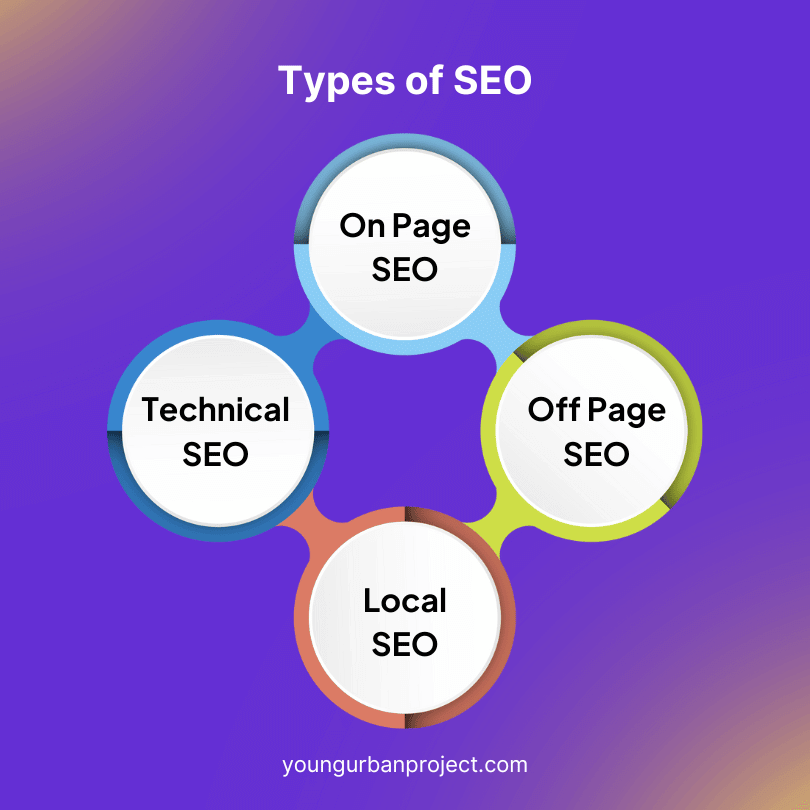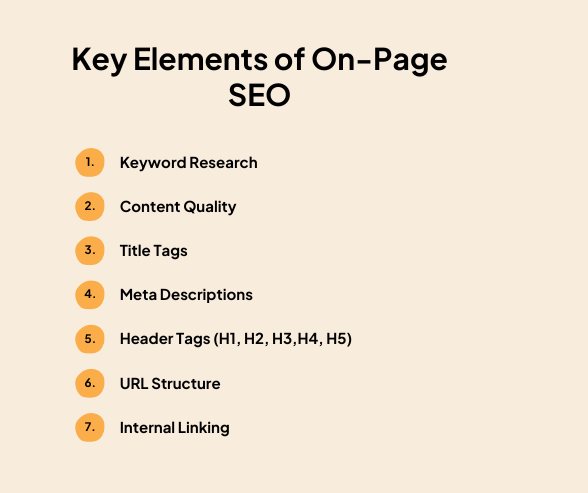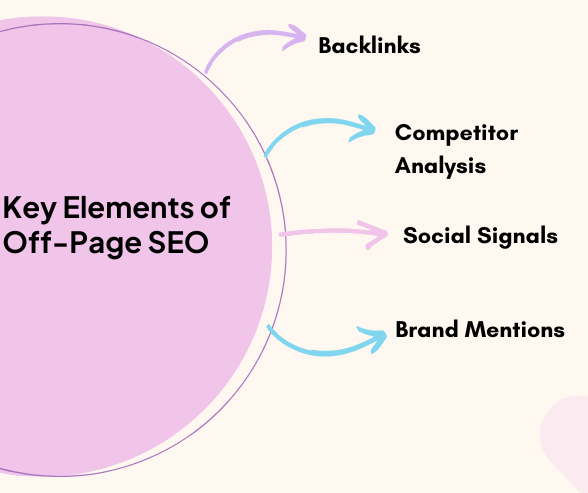Search Engine Optimization (SEO) is one of the quintessential components of a digital marketing strategy, enabling websites to rank higher on search engine results pages (SERPs) and attract organic traffic.
Understanding the different types of SEO is essential for developing a comprehensive strategy that improves visibility, drives engagement, and increases conversions. This guide explores the various types of SEO, offering insights into how each contributes to a successful online presence.

Table of Contents
1. On-Page SEO
On-page SEO entails improving individual web pages to boost search engine ranks and attract relevant traffic. This type of SEO focuses on elements within your control, such as content quality, keyword usage, and HTML tags. Effective on-page SEO ensures that search engines and users can understand your content, making it easier for your pages to rank higher in search results.
Key Elements of On-Page SEO

Keyword Research
Keyword research is the process of identifying and investigating relevant search keywords used by individuals when searching for a question or product online. Marketers strategically use these keywords in content to improve the rankings of web pages and increase brand awareness.
Content Quality
High-quality, relevant content that answers users’ queries is fundamental. Ensure that your content is comprehensive, well-researched, and engaging. Use targeted keywords naturally within the content, headings, and subheadings to help search engines understand your page’s topic. Avoid keyword stuffing, as it has a detrimental influence on readability and search ranks.
Title Tags
Create interesting, keyword-rich title tags that appropriately reflect the page’s content. Title tags are crucial for both search engines and users, as they appear in search results and browser tabs. Keep them concise (50-60 characters) and include primary keywords near the beginning.
Meta Descriptions
Write concise meta descriptions that include primary keywords and provide a clear overview of the page content. Although meta descriptions don’t directly affect rankings, they influence click-through rates by giving users a snapshot of what to expect on your page. Aim for 150-160 characters and make it enticing.
Header Tags (H1, H2, H3,H4, H5)
Use header tags to structure content, making it easier for search engines and users to understand the hierarchy and importance of information. The H1 tag should contain the main topic of the page, while the H2 and H3 to H6 tags can be used for subheadings and supporting points. This organization improves readability and keyword relevance.
URL Structure
Ensure URLs are clean, descriptive, and include relevant keywords. A well-structured URL helps search engines understand the page content and provides users with a clear idea of what the page is about. Avoid long, complex URLs and use hyphens to separate words.
Internal Linking
Link to other relevant pages within your site to help search engines understand your content’s structure and hierarchy. Internal links also guide users to additional valuable content, improving their overall experience. Use descriptive anchor text to indicate the linked page’s content.
2. Off-Page SEO
Off-page SEO refers to efforts that occur outside of your website and have an impact on your search engine rankings. This type of SEO is primarily about building backlinks, which are links from other websites pointing to your site. Off-page SEO signals to search engines that your site is valuable, credible, and authoritative, which can significantly boost your rankings.
Key Elements of Off-Page SEO

Backlinks
Backlinks are the backbone of off-page SEO. They act as votes of confidence from other websites, indicating that your content is trustworthy and valuable. However, not all backlinks are equal. High-quality backlinks from authoritative and relevant sites carry more weight than numerous low-quality links.
How to Build Backlinks
- Guest Blogging: Write guest posts for reputable sites in your industry. This not only earns you a backlink but also exposes your content to a broader audience.
- Influencer Outreach: Connect with influencers in your niche and ask them to share or link to your content.
- Content Marketing: Create valuable, shareable content like infographics, research studies, and comprehensive guides that other sites will want to link to.
- Broken Link Building: Find broken links on other websites and recommend your material as a replacement. This helps webmasters improve their sites while also earning you a backlink.
Competitor Analysis
Competitor analysis in off-page SEO involves examining the backlink profiles and strategies of your top competitors to identify opportunities and gaps in your strategy. By analyzing where your competitors are getting their backlinks, you can discover new prospects for link-building and understand what it takes to rank higher in search results.
Start by identifying your main competitors, which can be done using tools like Ahrefs, SEMrush, or Moz. Once you have a list, analyze their backlink profiles to see which sites are linking to them, the types of content attracting links, and the anchor text used. Pay attention to high-authority domains that frequently link to your competitors, as securing links from these sites can significantly boost your rankings.
Social Signals
Engagement on social media platforms can indirectly influence your rankings by driving traffic and increasing visibility. While social signals (likes, shares, comments) aren’t direct ranking factors, a strong social presence can amplify your content, leading to more backlinks and mentions.
How to Leverage Social Signals
- Share Content Regularly: Consistently share valuable content on your social media channels to engage your audience.
- Engage with Followers: Respond to comments, join relevant conversations, and build a community around your brand.
- Collaborate with Influencers: Partner with influencers to reach a wider audience and boost your social engagement.
Brand Mentions
References to your brand across the web, even without direct links, can enhance your site’s authority and credibility. Search engines recognize brand mentions as indicators of a site’s prominence and relevance.
How to Generate Brand Mentions
- Press Releases: Distribute press releases for significant events, product launches, or achievements to gain media coverage.
- Sponsorships and Partnerships: Sponsor events or collaborate with other businesses to get mentioned on their platforms.
- Online Reviews: Encourage customers to leave reviews on review sites and forums relevant to your industry.
3. Technical SEO
Technical SEO involves optimizing your website’s infrastructure to ensure search engines can crawl, index, and render your content efficiently. It focuses on increasing site speed, mobile usability, and overall performance. Technical SEO lays the foundation for your site’s visibility, making it easier for search engines to understand and rank your pages.
Key Elements of Technical SEO
Site Speed
Fast-loading pages enhance the user experience and are preferred by search engines. Slow websites can lead to high bounce rates and lower rankings. Optimizing site speed involves several techniques:
- Image Optimization: Compress images without sacrificing quality to reduce load times.
- Browser Caching: Enable browser caching to store resources locally, so returning visitors can load your site faster.
- Minify CSS, JavaScript, and HTML: Reduce file sizes by removing unnecessary characters, spaces, and comments.
Mobile-Friendliness
With the increasing use of mobile devices, ensuring your site is responsive and offers a seamless experience across all devices is crucial. Google uses mobile-first indexing, meaning it primarily uses the mobile version of your site for ranking and indexing.
- Responsive Design: Use responsive web design to ensure your site adapts to different screen sizes and resolutions.
- Mobile Usability: Make sure buttons and links are easily clickable, and text is readable without zooming.
- Page Speed on Mobile: Optimize for mobile-specific speed issues, such as reducing server response time and leveraging AMP (Accelerated Mobile Pages).
XML Sitemap
An XML sitemap helps search engines understand your site structure and index your pages correctly. It provides a list of all the important pages on your site, ensuring none are overlooked.
- Creating an XML Sitemap: Use tools like Yoast SEO or Google XML Sitemaps to generate a sitemap.
- Submitting the Sitemap: Submit your XML sitemap to Google Search Console and Bing Webmaster Tools to facilitate better indexing.
Robots.txt
The robots.txt file controls which pages search engines can crawl and index. Properly configuring this file ensures that search engines focus on your most important pages.
- Blocking Unimportant Pages: Prevent search engines from indexing pages like admin areas, duplicate content, or staging sites.
- Allowing Important Pages: Ensure critical pages and sections of your site are accessible to search engine bots.
SSL Certificate
Implement HTTPS to secure your site and improve trustworthiness. An SSL certificate encrypts data between your site and users, protecting sensitive information and enhancing security.
- HTTPS Implementation: Obtain an SSL certificate from a trusted provider and configure your server to use HTTPS.
- Redirect HTTP to HTTPS: Set up redirects to ensure all traffic goes through the secure HTTPS version of your site.
4. Local SEO
Local SEO is aimed at optimizing your online presence to attract more business from relevant local searches. This type of SEO is crucial for brick-and-mortar businesses looking to drive foot traffic and local leads. By focusing on local SEO, you can ensure that your business appears in local search results, making it easier for potential customers to find and visit your location.
If you’re a business owner who needs help with improving your local visibility, partnering with a local SEO company can make a significant difference. These companies specialize in optimizing your business for local search, helping you stand out in map listings, attract nearby customers, and enhance your presence on platforms like Google Business Profile.
Key Elements of Local SEO
Google Business Profile (GBP)
Google Business Profile (formerly known as Google My Business or GMB) is a free tool to manage your business’s appearance on Google Search and Maps. Optimizing your GMB listing can significantly improve your local search visibility.
- Claim and Verify Your Listing: Ensure your business is listed in GBP and verify ownership.
- Complete Your Profile: Fill out all relevant information, including business name, address, phone number, website, and business hours.
- Add Photos and Videos: Upload high-quality images and videos to showcase your business, products, and services.
- Collect Reviews: Encourage satisfied customers to leave positive reviews and respond to them to show you value customer feedback.
To conclude: Focus on all types of SEO
Understanding the different types of SEO and how they contribute to your overall strategy is crucial for achieving higher search engine rankings and driving organic traffic.
By focusing on On-Page, off-Page, Technical, Local SEO, you can create a comprehensive approach that enhances your online presence and supports your business goals. Implement these strategies consistently, and you’ll see a significant improvement in your website’s performance and visibility in search engine results.

